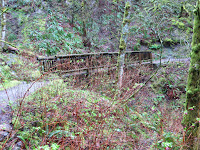Henry J. Biddle bought Beacon Rock for $1 in 1915 and spent the next three years designing and constructing a dizzying structure to the 848 foot summit. The 17 bridges and 54 switchbacks carry hikers to the top for views east and west along the Gorge, the distances being determined by the weather. River traffic glides below and the busy Interstate 84 of Oregon can be seen across the river. The route up the Rock is not for the faint of heart. Metal poles form the basis for see-through railings all the way up. The path does not circumvent the Rock; rather it zigzags back and forth over the southwestern face, leaving quite a view all the way down to the trailhead. Add the element of drenching rains with high winds and the journey becomes a debatable danger.
Being reasonable hikers we agreed to postpone an assault on the Rock and turned uphill, across Washington's Highway 14, to the trail toward Hamilton Mountain. This proved a good decision as Beacon Rock has suffered extensive winter damage and has been closed until repairs can be made. The suggested opening for "select areas" is about July 2016.
Warmup hikes are just that. They warm us up on short and less demanding trails in preparation for longer and more challenging hikes in the summer and fall. Hamilton Mountain's looped 7.5 mile trail and 2000 foot elevation gain offer impressive views on a clear day for the demanding climb, but early on the trail are three splashy waterfalls worth seeing at this time of year. The 2.5 mile round trip was just what we needed even though we had planned the additional two mile Rock climb.
Melting snow and rainwater hitting the tops of the mass of basalt rock that forms the canyon of the Columbia River Gorge slowly begin a seeping descent through tiny fractures in the columns, relinquishing their journey to gravity and random crevices. As single droplets join others they enlarge their volume and speed toward the basin. Periods of freezing and thawing labor to further open tiny fissures and even detach pieces of rock that go tumbling and bouncing downward until they find a resting place. Legions of these small water flows continue to find direction through larger and larger passageways until collectively they reach a ledge and cascade dramatically through thin air down a hundred feet or more onto another ledge. Here the powerful waterfall works to carve smoothly rounded pools which toss the splashing waters upward and outward in even more mist. Succeedingly lower and wider rock channels take the water to its next fall and perhaps another until a torrential gathering of rushing water reaches the Columbia River itself where it surges toward the largest body of water possible - the Pacific Ocean.
As water intermittently drizzled from the sky we began our hike from the State Park and kept steadily climbing along the trail. We found ourselves embarrassingly out of shape, having to stop more often than we had remembered necessary to catch our breath. This is the stuff of warmups. Keep at it. Step by step we gradually made some elevation gain and took in the greening beauty of a forest waking up after a snowy winter season.
The first to arise is the moss, spongy and tufted on its surface, housing the bulbs of colored wildflowers just beginning to emerge. Tiny pink twinflower-like bells silently chime in the soft breeze, just barely hovering over their damp footing. Bright yellow violets look like dots of midday sunshine while the infrequent white trillium is like a fading patch of winter's snow. Bleeding heart foliage bursts above the decaying mass of last year's beauty, readying a flush of dangling pink hearts on a line. The white umbels of cow parsnip are forming above delicately unfurling maple-like leaves, growing fast like a teenage boy. Oregon grape leaves, pointed in holly look-alike, are shiny with rain but not yet budding here as they are elsewhere further west. Tiarella or foam flower form puddles of lovely leaf clusters in preparation for their tall spikes of white flower wands. The ubiquitous sword ferns, still staunch with last year's growth, are a higher carpet layer providing darker shades of green against the various colors and textures of tree bark. They hide this year's tightly curled fronds which will replace them soon, pushing the older fronds to the ground to become fodder for another generation of ferns.
 |
| Misty Hamilton Mountain |
*** Links to Gorge history and formation
 |
| Yellow violets |
 |
| Trillium |
 |
| Trail bridge |
 |
| Falls through the trees |
 |
| Trail blocker |
 |
| Trail danger! |
 |
| Hardy Falls |
 |
| Checking out Pool of Winds |
 |
| Feel the wind? |
 |
| Top of falls |
 |
| Safety railing |
 |
| Tree caught downstream |
 |
| Rodney Falls |
 |
| Pools of roof water |
 |
| Talus behind shelter |
 |
| Death and new life |
 |
| Shelter stove |
 |
| Picnic set on mossy boulders |




No comments:
Post a Comment